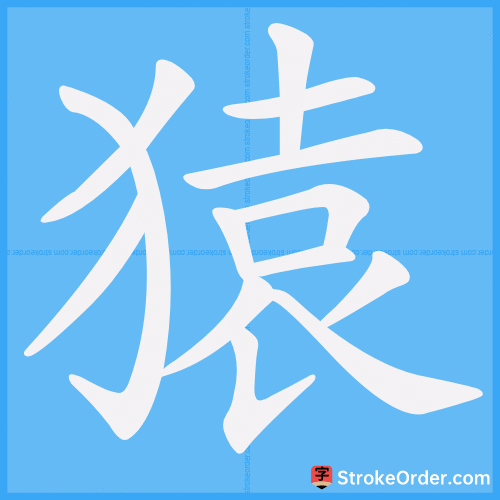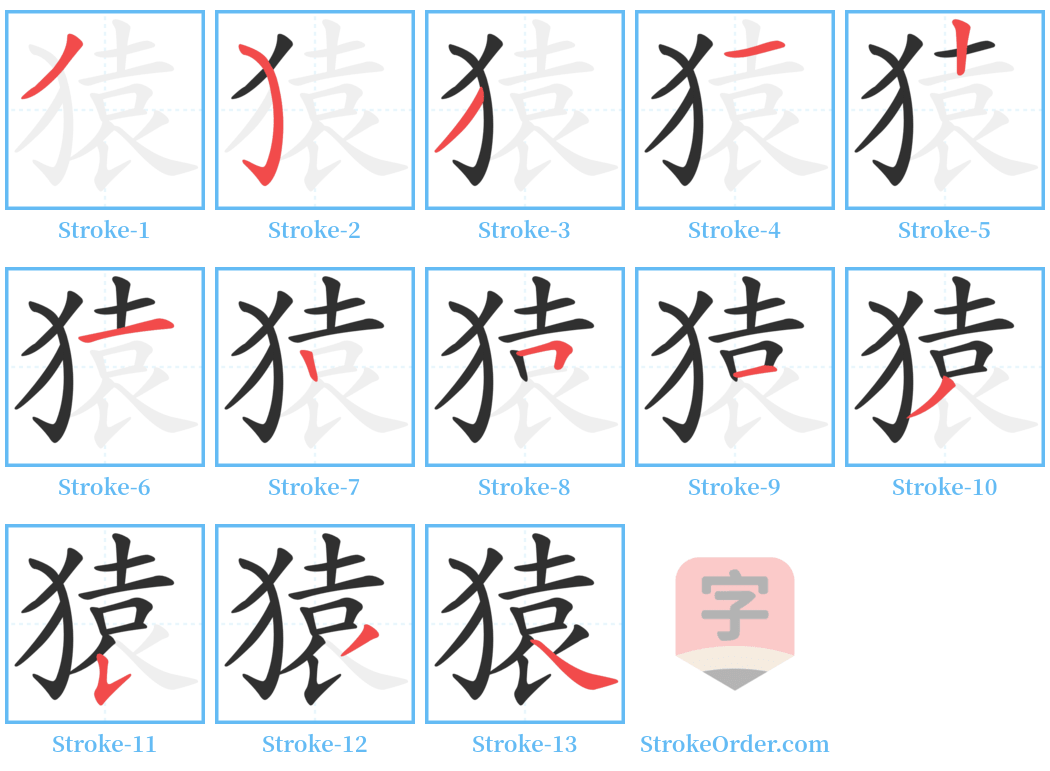猿 Stroke Order
Animated Stroke Order of 猿

Stroke Order Diagrams for 猿

Step-by-Step Handwriting Guide for 猿

Learn to Write Chinese Characters with Video Tutorials
Watch the video of writing the Chinese character "猿", learn the correct stroke order (笔顺) of the character "猿", and master the standard way of writing the character "猿".
Free Printable Handwriting Practice with Stroke Order: 猿
Printable Writing Practice Worksheet of "猿" in Portrait Orientation (Tian Zi Ge)

Printable Writing Practice Worksheet of "猿" in Landscape Orientation (Tian Zi Ge)

Information of 猿
Pinyin
yuán
Radical
犭
Strokes
13 strokes
Usage
★★★★★
Definition
ape
猿 (yuán)
1. A type of mammal that resembles monkeys but is larger, has no cheek pouch, and lacks a tail. Examples include orangutans, gorillas, and gibbons.
猿猴。猿人。
2. (Noun) The primary meaning: a primate that resembles monkeys in appearance.
【本义】: 灵长类动物,形态与猴相似
3. (Character creation method): A phonetic character combining the radical for dog (犬) and the sound of "yuan" (袁). The term includes "犬" because of the resemblance of apes to dogs.
【造字法】: 形声。从犬,袁声。猿似犬,故从犬。
引 (References):
1. From the "Shuowen Jiezi": "蝯善援,禺属." Commonly written as "猨、猿".
2. From "Kaogongji": "The raccoon dies if it crosses the Wen River. Note: 'the raccoon may refer to 猨, meaning the one that is good at climbing trees.'"
3. From "Shijing": "Do not instruct the climbing monkeys to ascend the trees. Comment: '猱, belongs to the 猨 category.'"
4. From "Zhuangzi": "The ape descends from the mountains and forests."
5. From "Han Dynasty, Dong Zhongshu's 'Chunqiu Fanlu'": "The reason for the longevity of apes is because they enjoy pulling at their tails, thus their energy surpasses others."
Examples:
猿猴献果 (refers to the posture of binding one’s limbs together in front); 猿狖 (ape); 猿眩 (ape looking down from a cliff); 猿臂 (arms as long as an ape, easily maneuvered, also used metaphorically for a favorable situation in combat).
lit. heart like a frisky monkey, mind like a cantering horse (idiom); fig. capricious (derog.) / to have ants in one's pants / hyperactive / adventurous and uncontrollable
Peking ape-man / Homo erectus pekinensis (c. 600,000 BC), discovered in Zhoukoudian 周口店[Zhou1 kou3 dian4] in 1921
Input Method for 猿
Pinyin
yuan2
Wubi
qtfe
Cangjie
khgrv
Zhengma
qmjr
Four Corner
44232
Unicode
U+733f
Same Pronunciation Characters